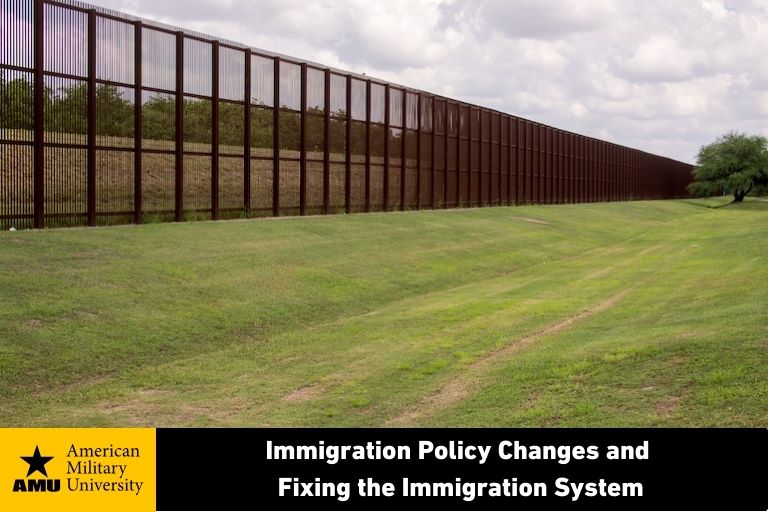By Dr. Jarrod Sadulski and Alicia Hopper | 08/28/2024

To fix the immigration problems facing the U.S., it will be necessary to implement immigration policy changes. But understanding the immigration policies that influence migration into the United States is crucial for American citizens. This bipartisan issue has been a challenge for decades and has been the subject of a lot of change.
The Role of the White House in Immigration
Immigration policies have changed throughout U.S. history. During the World War II era, President Roosevelt suspended immigration naturalization proceedings the day after the Pearl Harbor attack for immigrants from Italy, Germany, and Japan. He also restricted their mobility.
Also, the policies for lawful permanent residence and employment-based green cards have continuously evolved. The Obama administration launched Deferred Action for Childhood Arrivals (DACA) to provide temporary protection from deportation to qualified undocumented migrants who came to the U.S. as children.
The Trump administration focused heavily on immigration policy, particularly the construction of the border wall. The Trump administration also enacted the “Remain in Mexico” policy. This policy required certain asylum seekers who passed a credible fear screening with a U.S. asylum officer to remain in Mexico while awaiting an asylum hearing in a U.S. immigration court.
The Biden administration halted the border wall construction and allowed DACA recipients to immediately apply for lawful permanent residence, greatly benefitting certain immigrants. In the first three years of Joe Biden’s presidency, the Biden administration issued 535 immigration-related executive actions, outpacing the 472 actions taken during President Trump’s four years in office.
The Complex Structure of the US Immigration System
The U.S. immigration system is a complex structure and includes various programs. Some of these programs include temporary employment visas for immigrant workers and different visa categories such as:
- IR1, CR1 – A visa for a spouse of a U.S. citizen
- K-3 – A visa for a spouse of a U.S. citizen awaiting approval of an I-130 immigrant petition
- K-1– A visa for a fiancé to marry a U.S. citizen and live in the U.S.
- F2A, F2B – A visa for certain family members of lawful permanent residents
- T visa – A temporary visa of up to four years for human trafficking victims
- DV – A visa program that provides green cards to people from countries that have low immigration rates to the U.S. each year (this type of visa is involved in the “green card lottery”)
- Other visas designed for people who worked on behalf of the U.S. government, such as Afghan translators and other categories of people
Another important visa is the H-1B visa that provides work authorization through employers hiring nonimmigrant aliens for specialty occupations. The H-1B visa can lead to a migrant obtaining a green card or permanent residency.
According to the American Immigration Council, the United States may provide up to 675,000 permanent immigrant visas each year across various visa categories per the Immigration and Nationality Act (INA). The INA does not limit the number of children and young adults under the age of 21 who can be admitted into the United States as immigrants.
The American Immigration Council also notes that the president is required to consult with Congress to set an annual limit on the number of refugees who can be admitted to the U.S. under the U.S. Refugee Admissions Program.
U.S. Citizenship and Immigration Services defines “refugees” as individuals who:
- Are without legal status in the U.S.
- Are of special humanitarian concern to the U.S.
- Can demonstrate that they were persecuted or in fear of persecution due to race, religion, nationality, or being part of a particular social group
We are currently facing a crisis due to the large number of unauthorized immigrants who have flooded to the U.S., mostly from the southwest border. According to Customs and Border Protection (CBP), there were 8,410,951 encounters with migrants attempting to enter the United States at the southern border between October 2021 and June 2024. This number has increased from 2,475,669 migrant encounters in 2023.
It’s also crucial to note that numbers only represent the migrants encountered by Customs and Border Protection personnel. It does not account for illegal immigrants who were smuggled into the United States and remained undetected.
There are also other concerning statistics:
- Between October 2019 and June 2024, border officials encountered 11 million undocumented immigrants.
- The U.S. Congressional Committee on Homeland Security noted 1.8 million “gotaways” evaded CBP and entered the United States illegally in 2023.
This influx has overwhelmed immigration courts, judges, and the entire U.S. legal system. The CBP1 program, designed to manage migrants coming to the U.S. illegally, has been inundated with asylum claims that have further strained our legal system.
But waiting for an asylum hearing is dangerous. For instance, there are countless people in makeshift camps in Nuevo Progreso, Mexico, waiting for their CBP1 appointment regarding their asylum claims. These individuals lack security and are at risk of kidnapping and exploitation.
The Flood of Illegal Migration Has Caused Many Problems
There is a consensus among migrants that U.S. immigration laws are not currently being enforced, allowing nearly anyone to enter the country illegally by claiming asylum. Many immigrants are coming to the U.S. via Central America simply for better financial opportunities.
The flood of illegal migration has hindered asylum seekers who are in true danger of persecution or death in their home countries. Immigrant families with legitimate asylum claims may face deportation because they entered the U.S. illegally instead of through legal pathways.
Many families are being smuggled and trafficked into the U.S., leading to their expedited removal. That deportation has put the lives of those families at risk when they are deported to Latin American countries lacking adequate protections for their citizens.
The mass illegal migration has led to large-scale smuggling and trafficking operations by cartels, who are responsible for delivering undocumented immigrants to the southwest border of the U.S. Most migrants smuggled or trafficked to the border typically experience some form of violence and exploitation during their dangerous journeys. Often, they are robbed of their belongings or children, assaulted sexually by their smugglers, or see violent attacks or dead victims.
The influx of unaccompanied minors arriving at the border has also been exploited by cartels. A recent Congressional roundtable discussed how cartels play a role in trafficking unaccompanied minor children while the federal government attempts to find them sponsors.
About 85,000 unaccompanied migrant children have been processed at the border, and the federal government has lost contact with them.
The Office of Refugee Resettlement (ORR) has attempted to reunite these children with their families, but often those kids end up in the care of human traffickers. There have been many cases where children have been placed with sponsors who subject them to unacceptable labor conditions and trafficking situations.
Improved Security and Better Legal Pathways Are the Solution to the Migrant Crisis at the Border
No one wants to witness migrants risking their lives, being sexually exploited by cartels, having their children being kidnapped and trafficked, or seeing people dying as they risk their lives to cross the border. Legal immigration is essential to our economy and provides individuals with the opportunity to achieve the American dream and to become green card holders.
Jordan Fischetti, an Immigration Policy Fellow at Americans for Prosperity and a former immigration attorney, believes that "legal immigration and border security are complementary, not competing objectives."
But to achieve both goals of protecting people and ensuring legal immigration through an immigration court, a new approach to immigration policy is badly needed. Better legal pathways must be created to lead to work permits and support people who seek asylum for legitimate reasons. The U.S. government also needs to provide immigrants with pathways to obtain green cards through an orderly, case-by-case basis.
To address the immigration crisis in the U.S., it is necessary to properly secure the southwest border of the U.S. Retired Border Patrol Chief Chris Clem posits that “Currently, we have a system where our agents are spending the vast majority of their time processing asylum seekers, leaving the rest of our border open for bad actors to exploit.” This vulnerability reflects the critical need for enhanced border security.
The Department of Homeland Security has the capability to secure the border by completing the border wall in areas lacking natural land barriers. Enhancing surveillance with advanced equipment, which serves as a force multiplier for CBP, is also crucial. Additionally, investing in more CBP patrol personnel and equipment is essential for effective border security.
Securing the border will dispel the perception in Central America and around the world that the southern border of the U.S. is porous and allows many people to enter illegally and claim asylum, even if they are not genuinely fleeing persecution.
As of December 2023, immigration courts are experiencing a record backlog of 3 million pending cases with only 682 immigration judges to adjudicate them.
According to the Congressional Research Service, an additional 700 judges would be needed to clear this immigration court backlog within 10 years. Additionally, the U.S. Citizenship and Immigration Services is severely understaffed.
Once the pressure on the border is alleviated through improved security, the asylum claim process should be completely overhauled. Only the number of migrants that U.S. asylum officers can thoroughly screen should be allowed to enter the U.S.
Instead of blanket amnesty, a rigorous vetting should be implemented. The current system often fails to provide protection to the people who need it most, but proper vetting can effectively address this issue.
In addition to addressing the asylum crisis at the border, we need to establish legal and streamlined pathways for work permits and employment-based green cards. Thousands of foreign professionals in fields such as medicine, engineering, and technology can contribute significantly to the American economy.
Providing timely legal status to these immigrants who pass a vetting process is essential. Currently, those individuals seeking legal pathways to green cards face unnecessary roadblocks and delays.
The Unaccompanied Children Program (UCP), run by the ORR, also needs reform urgently. Whistleblowers have provided Senate testimony about the program’s shortcomings, which has led to unaccompanied migrant children being placed with unvetted sponsors who traffic them.
While the goal is family reunification, cartels have exploited these weaknesses by manipulating migrant children into requesting sponsors affiliated with the Transnational Criminal Organization (TCO) network. For example, there have been cases where children were delivered to sponsors who are members of MS-13.
To address this immigration crisis, these steps should be taken:
- Reinstate DNA testing to verify that sponsors claiming to be family members are actually related to a child. DNA familial testing at the border ended on May 31, 2023.
- Eliminate the relaxed or optional vetting of sponsors who take custody of migrant children from the Office of Refugee Resettlement
- Require thorough background checks for potential sponsors, disqualifying anyone with a history of illegal drug use, abuse, neglect, or a criminal record. Currently, these factors are not considered when sponsors are assigned to children.
- Share sponsor immigration status with law enforcement
- Strengthen post-release home studies to monitor the well-being of the placed migrant children
- Enhance protections for whistleblowers who report corruption and misconduct within the UC program to Congress or the Inspector General of Health and Human Services
A functioning immigration system is essential and the suggested steps for fixing it are consistent with a bipartisan Congressional Review Act, led by Senator Chuck Grassley. The Congressional Review Act would bring about meaningful reforms to the government's handling of migrant children through the Unaccompanied Children Program. Ideally, everyone in Congress should support this initiative.
Partner countries in Latin America have an important role in preventing unauthorized immigrants from risking their lives to come to the United States. Organizations in those countries should better educate migrants of the many dangers associated with being smuggled to the U.S. border. If more migrants are aware of the dangers of smuggling, they would be far less likely to risk the lives of their families.
Immigrants coming to the United States through legal pathways is essential for the health of our country. But immigration policy changes are needed today to increase the safety of migrants while they are en route to the border and stop the overflow of illegal immigration. A much better immigration system must be created to provide a scalable immigration system that provides the opportunity to achieve the American dream for people that qualify and maintain national security.
Homeland Security Degrees at American Military University
For adult learners interested in homeland security, defense, border and coastal security, and other similar topics, American Military University (AMU) offers two homeland security degrees:
- An online bachelor’s degree in homeland security
- An online master’s degree in homeland security
- A dual online master’s degree in emergency management and homeland security
Courses in these programs cover a wide range of topics, including privacy and civil liberties in homeland security, domestic terrorism, extremist groups, critical infrastructure protection, and homeland security legal and ethical issues. Courses are taught by experienced instructors with a deep knowledge of homeland security, intelligence, and national defense.
For more information, visit our program page.

Dr. Jarrod Sadulski is an associate professor in the School of Security and Global Studies and has over two decades in the field of criminal justice. He holds a bachelor’s degree Criminal Justice from Thomas Edison State College, a master’s degree in criminal justice from American Military University, and a Ph.D. in criminal justice from Northcentral University.
His expertise includes training on countering human trafficking, maritime security, mitigating organized crime, and narcotics trafficking trends in Latin America. Jarrod has also testified to both the U.S. Congress and U.S. Senate on human trafficking and child exploitation. He has been recognized by the U.S. Senate as an expert in human trafficking.
Jarrod frequently conducts in-country research and consultant work in Central and South America on human trafficking and current trends in narcotics trafficking. Also, he has a background in business development.

Alicia (Ali) Hopper is dedicated to combating human trafficking through rigorous research and data collection. She gathers information from diverse sources and uses thematic analysis to uncover emerging and critical trends in human trafficking. Ali is a member of a distinguished research team that has provided testimony and consulting to both the U.S. Senate and Congress. Ali has conducted research with Jarrod on the Southwest Border on human trafficking and has witnessed firsthand the impacts of trafficking and smuggling.
Traveling across the country, Ali shares her insights and findings on human trafficking, presenting on the most urgent issues in the field. She collects data from incarcerated former sex traffickers both in the U.S. and internationally, and engages directly with trafficking victims to deepen her understanding of the problem and develop effective mitigation strategies.
With her expertise, Ali is a leading voice in the fight against human trafficking, bringing crucial information and perspectives to policymakers and the public. For more information on Ali and links to her social media and website, check out https://linktr.ee/alihopper.
